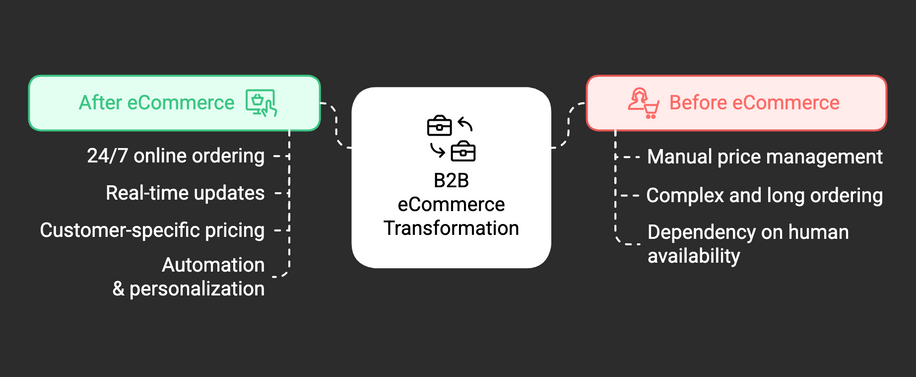How your organization evolves with B2B eCommerce. Before-and-after analysis

Imagine this: you’re drowning in documents, your sales team spends more time answering emails than closing deals, and your customers struggle just to place an order. Sounds familiar? That’s the "Before." Now picture the opposite: orders flow in automatically, your sales team is laser-focused on growth, and customers reorder in seconds. That’s the "After."
B2B platforms don’t get enough attention. And that’s a mistake. If you aren't online, you’re losing a significant share of the market. Millennials and Gen Z naturally turn to digital channels for their shopping needs. The pandemic also accelerated a digital shift.
↳ Forrester predicts that digital self-serve channels will process over 50% of large B2B transactions by 2025. Don’t wait – your competitors are already moving forward, and hesitation will only put you under pressure to keep up later.
Here’s the before and after picture that might convince you that B2B eCommerce isn’t a luxury – it’s a necessity. We will show you exactly what you can expect.

Before B2B eCommerce (The challenges)
Many organizations still rely on manual, traditional B2B sales models. Below is a deep dive into these challenges and why they complicate daily operations.
Sales only through representatives
Your clients can’t buy without speaking to a salesperson. While personal relationships are important, this approach is inefficient and leads to several issues:
- Dependency on human availability – Sales reps can only handle a limited number of customers at a time. Plus, if a customer wants to buy after hours, they won’t be able to until the next day.
- Bottlenecks during peak business times – Due to high demand, sales teams become overwhelmed with order requests, causing response delays and potential loss of business.
- Miscommunication risks – The risk of miscommunication also increases, which can damage business relationships. With so many touchpoints (emails, calls, paper forms), critical information like product specifications, pricing, or delivery details can get lost or misunderstood.
Example: Imagine a client urgently needs to reorder key components, but your sales rep is unavailable. The delay might lead to a stalled production line, forcing the client to look for alternatives elsewhere.
Long, complicated and error-prone ordering process
The traditional ordering process includes filling out forms, requesting quotes, waiting for responses, negotiations, confirming details. Clients expect updates, leading to multiple back-and-forth emails before finalizing an order.
Each of these steps introduces potential errors, such as missing details or incorrect pricing, quantities, product codes, and shipments. Manual processes also mean orders take much longer.
Sales team focuses on order management, not growth
Sales representatives are supposed to build relationships and acquire new clients, but in a traditional setup, they spend their time:
- Managing administrative tasks,
- Manually processing and coordinating orders,
- Answering repetitive customer questions and addressing even minor service concerns,
- Managing invoicing and follow-ups.
This not only affects productivity but also prevents businesses from scaling effectively because sales resources are tied up in operational tasks rather than revenue growth opportunities.
Disjointed internal systems = data silos
Many businesses operate with disconnected systems where inventory, customer data, and invoicing are stored separately. The result:
- Inaccurate stock information – Sales reps might sell products that are out of stock because inventory updates are delayed (no real-time visibility).
- Delayed order processing – Orders have to be manually transferred between departments, slowing down fulfillment.
- Inconsistent customer data – Customer order history, pricing agreements, and preferences are often spread across different systems, making it difficult to offer personalized service.
The lack of integration hampers your ability to make quick, informed decisions and leads to operational inefficiencies.
Inconsistencies and revenue leakage because of manual price management
Without clear guidelines and a structured pricing policy, sales reps may charge different rates for the same product.
Manually managing discounts and promotions makes errors more likely, affecting both profits and customer satisfaction. Volume-based pricing is difficult to manage across multiple clients.
Limited customer insights
Traditional B2B models lack robust analytics. Without insights into:
- Customer behavior – What products are most frequently purchased? When do clients reorder?
- Operational efficiency – Which processes are slowing down order fulfillment?
- Sales performance – Which customers are increasing or decreasing their purchases?
…your business decisions are based on assumptions, not data.
This lack of insight prevents you from proactively optimizing your sales strategies.
Example: If a competitor launches a promotional campaign and your major client starts reducing their order volume, you might not even realize why you’re losing business.
Complex approval processes
Many B2B sales involve:
- Multiple layers of internal approvals (e.g., senior managers, finance teams).
- Manual verification of large orders, slowing down fulfillment.
This adds unnecessary bureaucracy, causing frustration for both your team and your clients.
Example: A manufacturing company needs urgent parts, but because of the manual approval process, it takes days to confirm pricing and availability – resulting in costly production delays.
High cost of customer acquisition
Traditional B2B sales require significant time and effort to onboard a new customer. Your sales team has to train business customers on ordering procedures, send catalogs, pricing lists, and order forms, and provide constant support to answer basic questions.
This makes scaling your business costly and inefficient.
After B2B eCommerce (The transformation)
A B2B eCommerce platform is more than just an online store. It’s a game-changer for operational efficiency, sales strategy, and customer experience. Let’s break down how this transformation impacts your business.
Seamless online ordering for customers
Clients enjoy the convenience of:
- Browsing products – Customers can view product specifications, pricing, and stock levels in real time.
- Placing orders anytime – Orders can be placed outside traditional working hours, speeding up transactions.
- Reordering with one click – Frequently ordered items can be saved for instant reordering.
- Tracking orders – Customers receive automatic shipping updates and estimated delivery times.
The result? This self-service model improves satisfaction and loyalty. Clients appreciate the freedom to manage their orders.
Sales team focuses on high-value activities
With routine tasks automated, your sales reps can concentrate on what they do best – building relationships and identifying new opportunities in different regions or industries.
Order confirmations, shipping updates, and payment reminders are handled automatically, providing quick, accurate responses without manual intervention.
With access to customer purchase history, sales teams can engage with clients to understand their needs and recommend tailored solutions. They proactively suggest relevant add-ons or premium alternatives (upselling & cross-selling opportunities).
Integrated systems for maximum efficiency
A fully integrated B2B platform syncs with your inventory, warehouse, and shipping systems, ensuring seamless data flow:
- Real-time inventory updates – Prevents stockouts and over-ordering.
- Faster order processing – Reduces manual data entry and eliminates order duplication.
Integrated platforms also improve communication between sales, marketing, finance, and logistics, creating a more cohesive business environment.
Dynamic pricing and discount automation
B2B e-commerce allows for flexible, automated pricing strategies and more competitive offers:
- Customer-specific pricing – Pricing rules can be tailored for different customer segments (e.g., VIP clients, returning clients, wholesale buyers).
- Bulk order discounts – Businesses can configure volume discounts that activate instantly when customers reach the specified order size.
- Time-sensitive promotions – Special pricing campaigns can be pre-scheduled (e.g., end-of-quarter sales, seasonal discounts). This eliminates the need for manual negotiation or intervention.
Faster invoicing & payments
Automated invoicing ensures:
- Instant invoice generation – Customers receive invoices immediately after purchase.
- Multiple payment options – Credit terms, digital wallets, and bank transfers can be seamlessly integrated into your B2B platform.
- Fewer late payments – Automated payment reminders reduce overdue invoices.
Simplified approval workflows
Large B2B orders often require internal approvals. An e-commerce platform streamlines this by:
- Automating approval requests – Orders above a set threshold automatically trigger manager approval. Notifications and role-based permissions ensure that the right people review and approve orders promptly.
- Reducing manual bottlenecks – Employees don’t need to chase approvals via email or phone.
- Ensuring compliance – The system keeps purchases aligned with corporate procurement policies.
Lower customer acquisition costs
Self-service portals make it easier (and cheaper) to onboard new clients. Prospects can explore products, register, and place orders without extensive hand-holding. Videos, guides, and chatbots assist new clients without human intervention.
Analytics & personalized customer experiences
Instead of relying on assumptions, businesses can now leverage advanced analytics to increase customer loyalty:
- Track customer buying behavior – Identify trends, create product recommendations based on purchase history, and targeted marketing campaigns.
- Optimize product offerings – Analyze slow-moving products and introduce promotional strategies.
- Improve forecasting – Use predictive analytics to anticipate demand spikes with greater accuracy and adjust inventory levels.
Scalability without growing pains
A digital B2B platform allows businesses to expand to new markets, launch new products, or handle increased order volumes without needing a proportional increase in operational costs.
Why B2B e-commerce has become so urgent
In today’s fast-paced B2B environment, customers expect the same convenience they experience in B2C shopping.
Implementing a B2B e-commerce platform isn’t just about moving your catalog online. We’re talking about a complete transformation in how your business operates, making life easier for both your team and your customers. Before, business success relied heavily on in-person visits and face-to-face networking. Now, B2B platforms handle most of the sales journey, leaving sales reps to focus on large accounts with multi-year agreements.
Ready to simplify your B2B sales? Let’s talk about how eCommerce solutions can make it happen. Move from reactive to proactive, from manual to automated, from complex to streamlined.
You may also like:
↳ A before and after story of ZARYS: ZARYS, a manufacturer of disposable medical equipment, struggled with slow and outdated phone and email sales, making it tough for business customers to order medical supplies. By switching to a modern B2B platform, they now offer real-time updates, secure transactions, and a seamless online ordering experience. Discover their transformation!
↳ Key features every B2B eCommerce needs.
↳ eCommerce trend predictions for 2025 that businesses should pay attention to.



